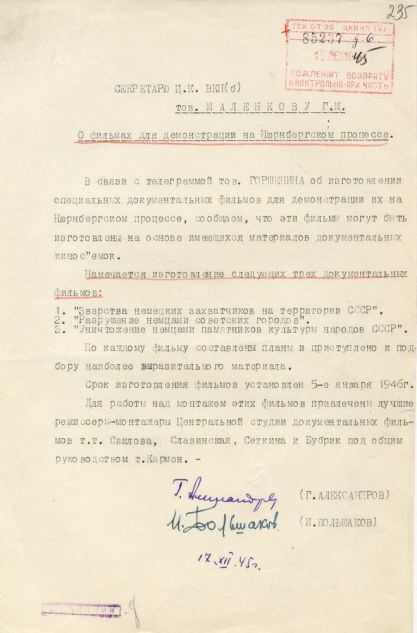Dmitry Astashkin, candidate of historical sciences (PhD) and senior researcher at the St. Petersburg Institute for History of the Russian Academy of Sciences, described how the Soviet side prepared documentary evidence for the International Military Tribunal in Nuremberg.
On the eight day of the Nuremberg Trials, 29 November 1945, US Assistant Prosecutor James Donovan presented the first film evidence of the trial, the documentary “The Nazi Concentration Camps.” It was a compilation of footage shot immediately after the liberation of the camps by American troops.
Prosecutor General of the Soviet Union Konstantin Gorshenin sent a telegram to Moscow about the production of similar documentaries. Georgy Aleksandrov, head of the Propaganda and Agitation Department of the Central Committee of the All-Union Communist Party (Bolsheviks), and Ivan Bolshakov, chairman of the Committee on Cinematography under the Council of People's Commissars of the Soviet Union, assigned the experienced front-line camera operator Roman Karmen to lead the project. He had previously filmed Nazi atrocities in liberated camps. Karmen was also internationally acclaimed as a correspondent for the US news agency United Press.
Karmen was filming the trials in Nuremberg but he wrote the film script for his Moscow colleagues and coordinated the editing remotely. According to the memoirs of the writer Boris Polevoy, a journalist who reported on the trials: “Roman Karmen... had already told me that they were preparing to ‘plant a bomb’ under the defendants' bench, a bombshell film that would be remembered by everyone. While he and his crew were working here at the trials, in Moscow they were making a film based on his script out of the footage shot during the war.” This was how the newsreels of 1941-1945 showing the Nazi crimes – from the outskirts of Moscow to Auschwitz-Birkenau – were edited.
The 45-minute documentary “Film Documents of Atrocities Committed by the German-Fascist Invaders” was completed very quickly on 21 December 1945. And on 19 February 1946, Lev Smirnov, Assistant to the Chief Prosecutor for the USSR, presented the film to the Tribunal at Nuremberg. It served as official evidence from the USSR.
























